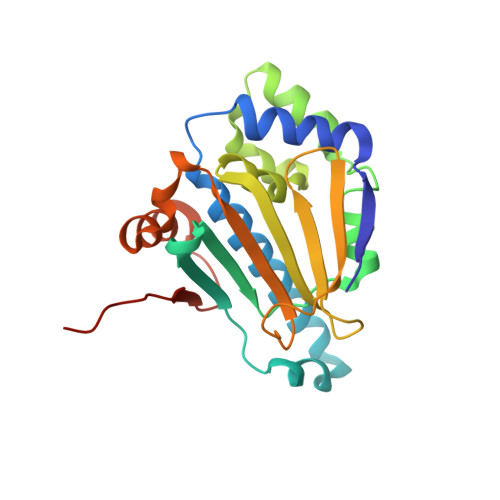Features of the Streptomyces Hygroscopicus Htpg Reveal How Partial Geldanamycin Resistance Can Arise with Mutation to the ATP Binding Pocket of a Eukaryotic Hsp90.
Millson, S.H., Chua, C., Roe, S.M., Polier, S., Solovieva, S., Pearl, L.H., Sim, T., Prodromou, C., Piper, P.W.(2011) FASEB J 25: 3828
- PubMed: 21778327
- DOI: https://doi.org/10.1096/fj.11-188821
- Primary Citation of Related Structures:
2YGA, 2YGE, 2YGF - PubMed Abstract:
Much attention is focused on the benzoquinone ansamycins as anticancer agents, with several derivatives of the natural product geldanamycin (GdA) now in clinical trials. These drugs are selective inhibitors of Hsp90, a molecular chaperone vital for many of the activities that drive cancer progression. Mutational changes to their interaction site, the extremely conserved ATP binding site of Hsp90, would mostly be predicted to inactivate the chaperone. As a result, drug resistance should not arise readily this way. Nevertheless, Streptomyces hygroscopicus, the actinomycete that produces GdA, has evolved an Hsp90 family protein (HtpG) that lacks GdA binding. It is altered in certain of the highly conserved amino acids making contacts to this antibiotic in crystal structures of GdA bound to eukaryotic forms of Hsp90. Two of these amino acid changes, located on one side of the nucleotide-binding cleft, weakened GdA/Hsp90 binding and conferred partial GdA resistance when inserted into the endogenous Hsp90 of yeast cells. Crystal structures revealed their main effect to be a weakening of interactions with the C-12 methoxy group of the GdA ansamycin ring. This is the first study to demonstrate that partial GdA resistance is possible by mutation within the ATP binding pocket of Hsp90.
- Department of Molecular Biology and Biotechnology, The University of Sheffield, Sheffield, UK.
Organizational Affiliation:

















